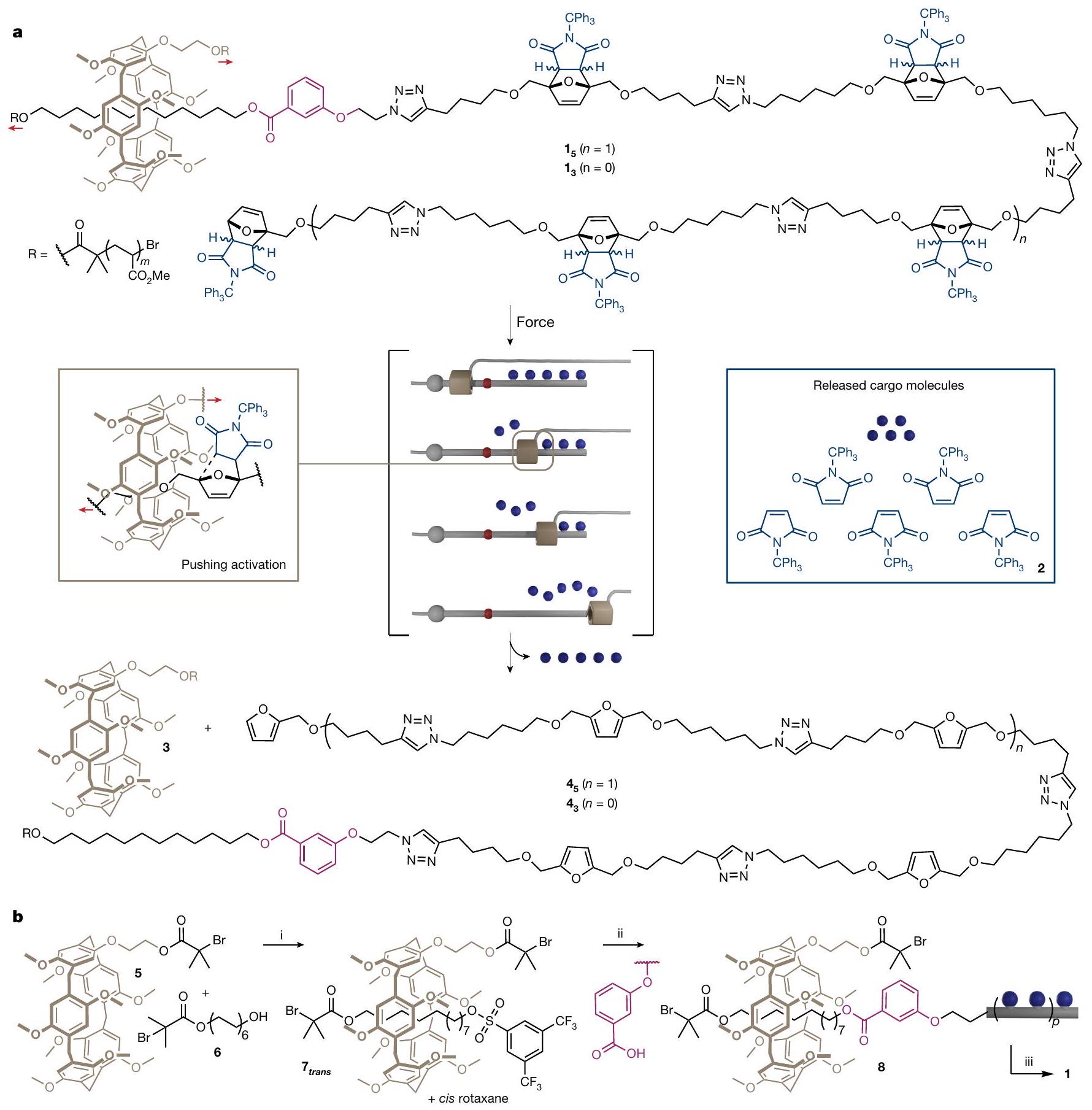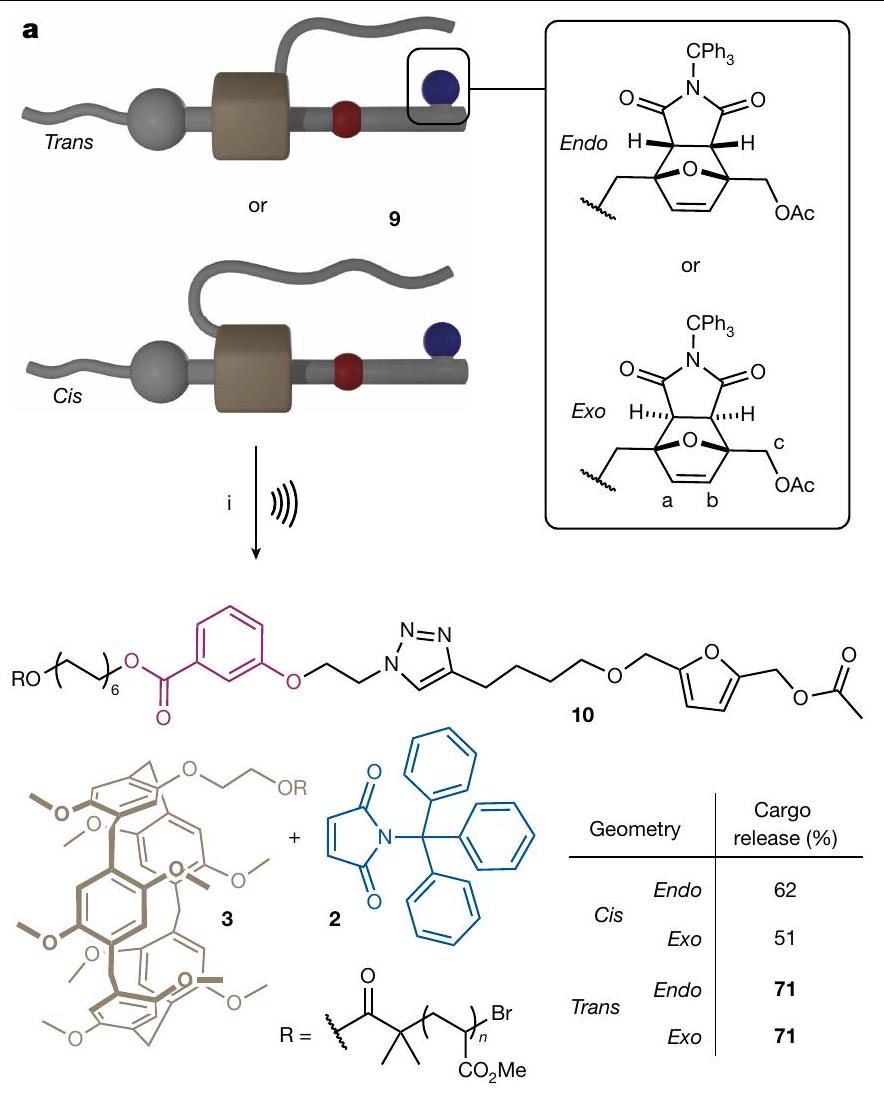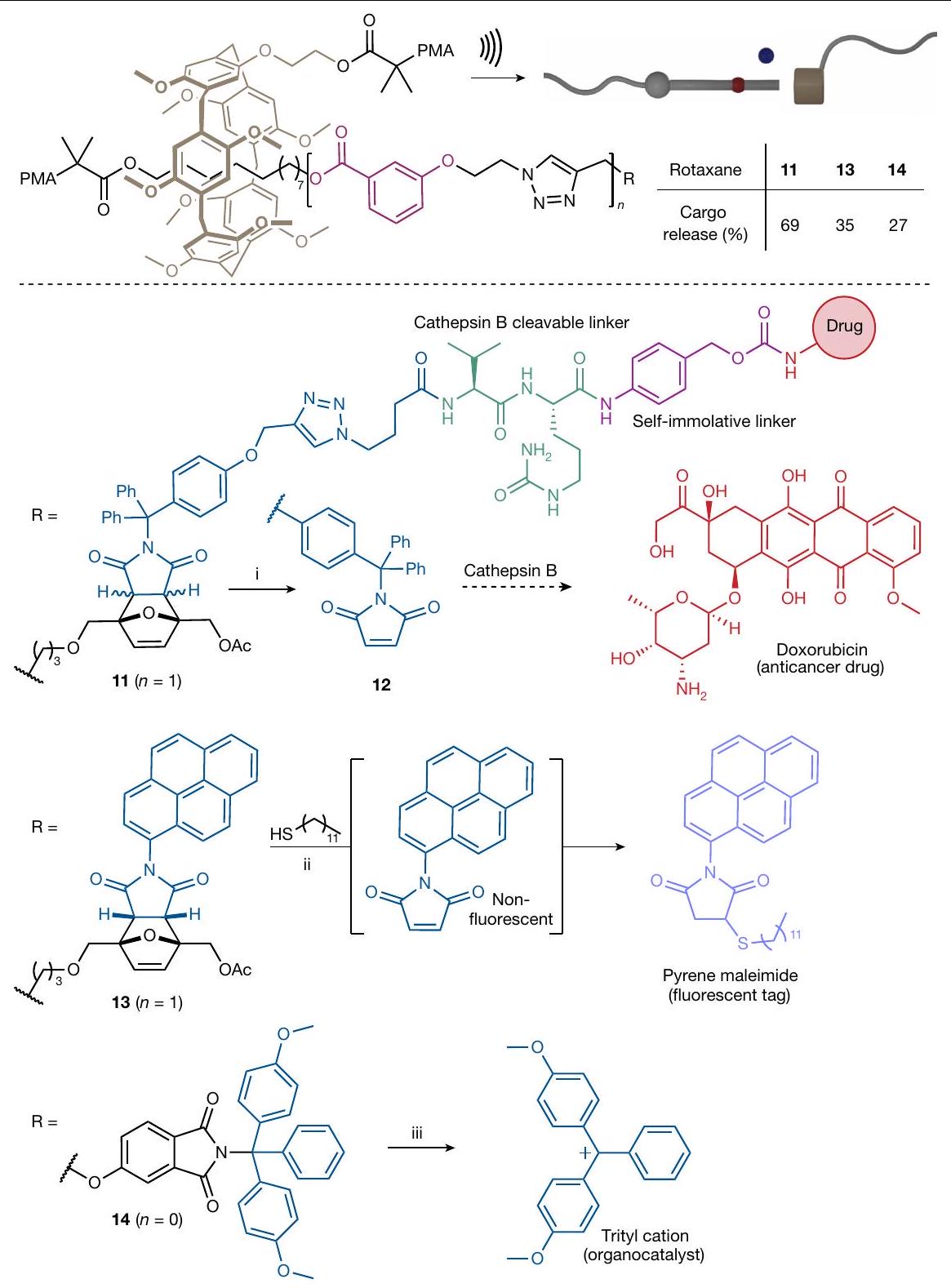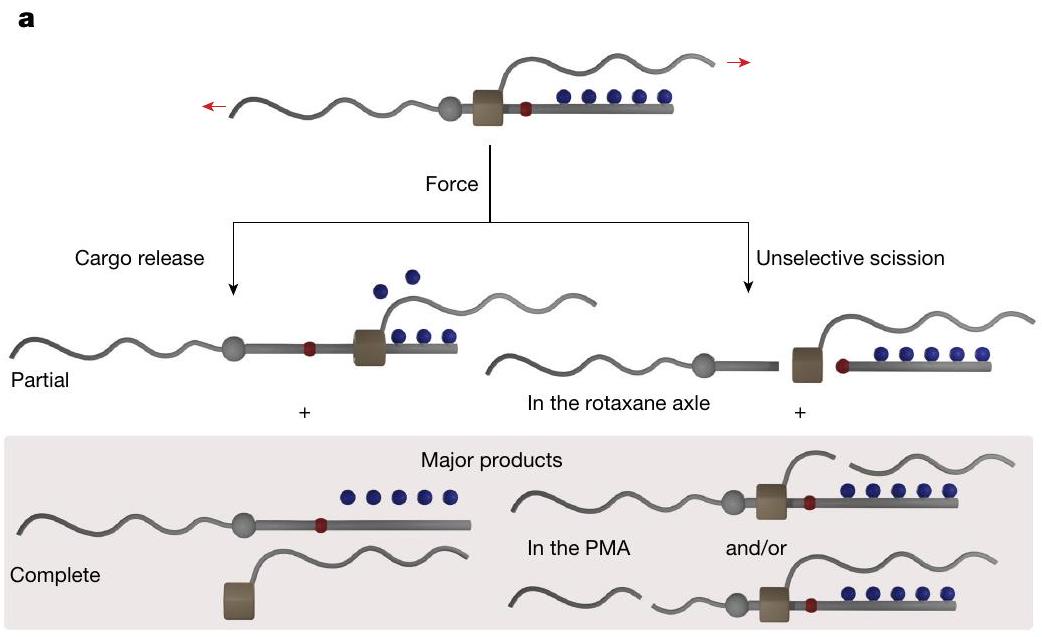DOI: https://doi.org/10.1038/s41586-024-07154-0
PMID: https://pubmed.ncbi.nlm.nih.gov/38600268
تاريخ النشر: 2024-04-10
إطلاق الجزيئات الصغيرة تحت السيطرة القوية باستخدام مشغل روتاكسين
تاريخ الاستلام: 28 مارس 2023
تم القبول: 2 فبراير 2024
نُشر على الإنترنت: 10 أبريل 2024
الوصول المفتوح
(T) تحقق من التحديثات
الملخص
الإفراج المتحكم فيه بالقوة عن الجزيئات الصغيرة يقدم وعدًا كبيرًا لتوصيل الأدوية وإطلاق عوامل الشفاء أو الإبلاغ في سياق طبي أو مواد.
تصميم

تصميم مشغل الروتاكسين 1، القادر على إطلاق ما يصل إلى خمس وحدات شحن لكل سلسلة. يتم بناء الروتاكسين حول ماكرو حلقة [5] أرين، والتي يمكن أن تحفز إطلاق
يتم سحبها على طول حجرة الشحن حتى تخرج (الشكل 1أ). يتم إطلاق ما يصل إلى خمس وحدات شحن مع الروتكسين،
تركيب
سلسلة، التي تتعرض لأكبر شدة من القوة أثناء السونication (انظر أدناه)

دراسة نموذجية

الموجات الصوتية، جنبًا إلى جنب مع المركب المرجعي
إيزومر لتجميع الهياكل الأكبر. يمكن استرداد جزيئات الحمولة عن طريق استخراج بقايا البوليمر بعد الصوتنة باستخدام الميثانول (قسم المعلومات التكميلية 6). تحليل هذا المستخلص بواسطة
نطاق الإفراج عن الشحن

تنشيط الروتاكسينات متعددة الحمولة في المحلول
بشكل كامل (الشكل 4أ). تم تعريض المحاليل المخففة من هذه البوليمرات للموجات فوق الصوتية حتى يحدث على الأقل قطع واحد (رابطة تساهمية أو ميكانيكية) في السلسلة الرئيسية (أي حتى يتم ملاحظة






معلمات الهيكل والتنشيط لروتاكسينات تمثيلية ذات حمولة واحدة وثلاث حمولات وخمس حمولات. نسبة القطع غير الانتقائي تجمع بين قطع PMA وقطع المحور. الخطأ النسبي في القطع غير الانتقائي وإطلاق الحمولة.
تظهر كفاءة الإطلاق انخفاضًا واضحًا مع زيادة طول حجرة الحمولة، ولكن، نظرًا لأن الحلقة الكبيرة لا تُلاحظ أنها تتوقف في منتصف الطريق (كما تم مناقشته أعلاه)، فمن المحتمل أن يكون الانخفاض في الكفاءة ليس قيدًا جوهريًا من مشغل الروتاكسان؛ قد يكون هذا بسبب تكوين بوليمرات أقل تحديدًا عندما يتم بدء البلمرة من مثل هذه الجزيئات الكبيرة. في هذه الحالة، من غير المرجح أن يكون الروتاكسان موجودًا في مركز السلسلة، التي تتعرض لأعلى شدة من القوة أثناء السونication، ويصبح الانقسام غير الانتقائي لسلسلة PMA هو السائد.
تفعيل بالجملة
مما سيؤدي إلى تنشيط أكبر
الاستنتاجات
يؤدي الماكروسايكل على المحور إلى تنشيط وإطلاق متتابع لشحنات الجزيئات الصغيرة. تتيح بنية الروتاكسان التشغيل التكراري للميكانيكوفور القابل للقص لأن البوليمرات المشغلة غير مرتبطة مباشرة بالميكانيكوفور. هذه البنية فريدة أيضًا في الطريقة التي تنشط بها الميكانيكوفورات، حيث تعتمد على هندسة الدفع بدلاً من السحب. لقد أظهرنا أن مثل هذا الجهاز الجزيئي يمكنه إطلاق ما يصل إلى خمس وحدات شحن لكل سلسلة سواء في المحلول أو في الكتلة. كفاءة تنشيط تصل إلى
المحتوى عبر الإنترنت
- فيرساو، ب. أ.، زينغ، ت.، هو، إكس. وروب، م. ج. استغلال قوة القوة: تطوير الميكانيكوفور لتحرير الجزيئات. ج. أم. كيم. سوس. 143، 21461-21473 (2021).
- كونغ، ر.، غوستل، ر. وشميت، ب. م. إطلاق الحمولة الجزيئية من أنظمة البوليمر بواسطة الكيمياء الميكانيكية. كيم. يور. ج. 28، e202103860 (2022).
- تشانغ، ي.، يو، ج.، بومبا، هـ. ن.، زو، ي. و غو، ز. توصيل الأدوية المحفز بالقوة الميكانيكية. مراجعة الكيمياء 116، 12536-12563 (2016).
- ويليس-فوكس، ن.، روجنين، إ.، الجهاني، ت. أ. ودالي، ر. الكيمياء الميكانيكية للبوليمرات: التصنيع أصبح الآن قوة يجب أخذها بعين الاعتبار. كيم 4، 2499-2537 (2018).
- لين، ي.، كوزنتسوفا، ت. ب. وكريغ، س. ل. آلية ميكانيكية خفية لتغير اللون الزمني والإشارات الكيميائية في المواد البوليمرية. مجلة الجمعية الأمريكية للكيمياء 142، 99-103 (2020).
- سوادا، ك.، ليونغ، أ. و.، لو، هـ. ل. هـ. ودي بو، ج. إطلاق الفوران عبر تفاعل السيكلوإضافة العكسي المعزز بالقوة [4+2][3+2]. ج. أم. كيم. سوس. 145، 20782-20785 (2023).
- ديزيندروك، سي. إي. وآخرون. تحويل ميكانيكي مرتبط بالبروتون: حمض ناتج عن الآلية. ج. أم. كيم. سوس. 134، 12446-12449 (2012).
- شي، ز.، سونغ، ق.، غوستيل، ر. وهيرمان، أ. تفعيل ميكانيكي كيميائي للبوليمرات متعددة الوظائف القائمة على ثنائي الكبريتيد لإطلاق الأدوية العلاجية التشخيصية. علوم الكيمياء 44، 25 (2021).
- هو، إكس.، زينغ، تي.، هوسيك، سي. سي. وروب، إم. جي. إطلاق جزيئات صغيرة مُحفزة ميكانيكياً من كربونات الفورفوريل المخبأة. ج. أم. كيم. سوس. 141، 15018-15023 (2019).
- سون، ي. وآخرون. إطلاق أول أكسيد الكربون المحفز ميكانيكياً مع انبعاث متزايد ناتج عن التجميع. مجلة الجمعية الأمريكية للكيمياء 144، 1125-1129 (2022).
- كونغ، ر.، باوش، ت.، راش، د.، غوستل، ر. وشميت، ب. م. الإفراج الميكانيكي الكيميائي عن الضيوف غير المرتبطين تساهميًا من قفص فوق جزيئي مزين بالبوليمر. أنجيو. كيم. إنترناشونال. إد. إنجلي. 60، 13626-13630 (2021).
- هوا، س. وآخرون. قطع الروابط الميكانيكية الكيميائية لتفعيل الأدوية. نات. كيم. 13، 131-139 (2021).
- دي جيانانتونيو، م. د. وآخرون. إطلاق أيونات المعادن المحفزة والأكسدة: الفيروسيئين كميكانيكوفور في البوليمرات. أنجيو. كيم. إنترناشونال. إد. إنجل. 57، 11445-11450 (2018).
- شا، ي. وآخرون. تعميم الكيمياء الميكانيكية للميتالكين إلى الميكانيكوفورات الروثينوسين. علوم الكيمياء 10، 4959-4965 (2019).
- لارسن، م. ب. وبويدستون، أ. ج. “المؤثرات الميكانيكية النشطة”: استخدام الكيمياء الميكانيكية للبوليمرات لتوجيه تنشيط انحناء الروابط. ج. أم. كيم. سوس. 135، 8189-8192 (2013).
- نيجم، س.، سونغ، ي.، شوارز، ر. وديزيندروك، س. إ. إنتاج ميكانيكي كيميائي مفعل بالمرونة لثاني أكسيد الكربون للكشف عن الأضرار الميكانيكية. كيمياء البوليمرات 13، 3986-3990 (2022).
- دي بو، ج. الكيمياء الميكانيكية للرابطة الميكانيكية. علوم الكيمياء 9، 15-21 (2018).
- ساغارا، ي. وآخرون. الروتاكسانات كأجهزة استشعار ضوئية ميكانيكية في البوليمرات. مجلة الجمعية الأمريكية للكيمياء 140، 1584-1587 (2018).
- ساغارا، ي. وآخرون. تمكين البوليمرات من خلال الميكانيكيات المعتمدة على الروتاكسين مع الفلورية البيضاء القابلة للتبديل ميكانيكياً. ACS Cent. Sci. 5، 874-881 (2019).
- موراماتسو، ت. وآخرون. ميكانوفورات مزدوجة الوظيفة قائمة على الروتاكسين تظهر استجابات عكسية وغير عكسية. ج. أم. كيم. سوس. 143، 9884-9892 (2021).
- تورينتس، ر. س.، كار، ت. ودي بو، ج. أ. روتاكسين مرتبط بالهيدروجين ميكانوكروما. مكروبول. رابد كوم. 42، 2000447 (2021).
- تشانغ، م. ودي، ب. ج. تأثير الرابطة الميكانيكية على تنشيط الميكانيكوفور. مجلة الجمعية الأمريكية للكيمياء 140، 12724-12727 (2018).
- تشانغ، م. ودي بو، ج. القابلية الميكانيكية للروتكسين. مجلة الجمعية الأمريكية للكيمياء 141، 15879-15883 (2019).
- ثوردارسون، ب.، بيجسترفيلد، إ. ج. أ.، روان، أ. إ. & نولتي، ر. ج. م. أكسدة الإيبوكسي للبولي بيوتادين بواسطة محفز مرتبط طوبولوجيًا. ناتشر 424، 915-918 (2003).
- لوسي، ب. وآخرون. جزيء صغير صناعي واحد يولد قوة ضد حمل. نات. نانو تكنولوجي. 6، 553-557 (2011).
- دي بو، ج. وآخرون. آلة جزيئية صناعية تبني محفزًا غير متماثل. نات. نانو تكنولوجي. 13، 381-385 (2018).
- تاكاتا، ت. مواد بوليمر قابلة للتبديل يتم التحكم فيها بواسطة مفاتيح ماكرومولكولية من نوع روتاكسين. ACS Cent. Sci. 6، 129-143 (2020).
- أوجوشي، ت.، كاناي، س.، فوجينامي، س.، ياماجيشي، ت. & ناكاموتو، ي. الأعمدة المتناظرة الموصلة عبر الجسور: تخليقها المحفز بواسطة حمض لويس وخصائصها كموطن وضيف. ج. أم. كيم. سوس. 130، 5022-5023 (2008).
- ستيفنسون، ر. ودي، بو، ج. التحكم في التفاعل من خلال الهندسة في تفاعلات ريترو-دييلز-ألدير تحت الضغط. ج. أم. كيم. سوس. 139، 16768-16771 (2017).
- أنستاساكي، أ. وآخرون.
البوليمرة الجذرية الحية المتوسطة: أداة متعددة الاستخدامات لتخليق المواد. مراجعة الكيمياء 116، 835-877 (2016). - نيرنجارتن، I. ونيرنجارتن، J. التحضير الموجه نحو التنوع للروتكسينات [2] المحتوية على أرين عمود [5] بواسطة استراتيجية تبادل السدادات. ChemistryOpen 9، 393-400 (2020).
- وو، ل. س. ودي بو، ج. تأثيرات الاستريوإلكترونية في تفاعلات ريترو-دييلز-ألدر المعجلة بالقوة. سينليت 33، 890-892 (2022).
- ماي، ب. أ. ومور، ج. س. الكيمياء الميكانيكية للبوليمرات: تقنيات لتوليد القوة الجزيئية عبر التدفقات التمددية. مراجعات الجمعية الكيميائية 42، 7497-7506 (2013).
- دوبيتشك، ج. م. وآخرون. روابط ثنائية الببتيد القابلة للتحلل بواسطة الكاتيبسين ب لإطلاق الدوكسوروبيسين من المناعية الداخلية: دراسات نموذجية لإطلاق الدواء بواسطة الإنزيمات ونشاط مضاد السرطان المحدد بالمستضد في المختبر. الكيمياء الحيوية المرتبطة. 13، 855-869 (2002).
- تاكار، أ.، سريامورنساك، ب. وداس، س. ر. دوكسوروبيسين: تحديث حول العمل الجزيئي المضاد للسرطان، السمية وأنظمة توصيل الأدوية الجديدة. ج. فارم. فارمكول. 65، 157-170 (2013).
- سابنيس، ر. و. دليل الأصباغ والمجسات الفلورية (وايلي، 2015).
- نايدو، ف. ر.، ني، س. و فرانزين، ج. الكربوكاتيون: محفز حمض لويس المنسي. كيم كات كيم 7، 1896-1905 (2015).
- أوفرهولست، أ. سي. وروب، م. ج. دراسة تأثير نشاط الميكانيكوفور النسبي على انتقائية الانقسام السلسلي الميكانيكي الكيميائي الناتج عن الموجات فوق الصوتية. رسائل أكس ماكرو. 11، 733-738 (2022).
- تشن، ي. وآخرون. الكيمياء الضوئية الناتجة عن التحفيز الميكانيكي من البوليمرات التي تحتوي على وحدة 1،2-ديكسيتان في السلسلة الرئيسية. نات. كيم. 4، 559-562 (2012).
(ج) المؤلفون 2024
مقالة
طرق
التفعيل الميكانيكي في المحلول بواسطة الموجات فوق الصوتية
التفعيل الميكانيكي في الكتلة بواسطة الضغط
تحليل المادة تقليصًا كافيًا في
توفر البيانات
معلومات إضافية
يجب توجيه المراسلات وطلبات المواد إلى غيوم دي بو. معلومات مراجعة الأقران: تشكر Nature آن-سوفي دوويز والمراجعين الآخرين المجهولين على مساهمتهم في مراجعة الأقران لهذا العمل. تتوفر معلومات إعادة الطبع والأذونات على http://www.nature.com/reprints.


DOI: https://doi.org/10.1038/s41586-024-07154-0
PMID: https://pubmed.ncbi.nlm.nih.gov/38600268
Publication Date: 2024-04-10
Force-controlled release of small molecules with a rotaxane actuator
Received: 28 March 2023
Accepted: 2 February 2024
Published online: 10 April 2024
Open access
(T) Check for updates
Abstract
Force-controlled release of small molecules offers great promise for the delivery of drugs and the release of healing or reporting agents in a medical or materials context
Design

a, Design of rotaxane actuator 1, able to release up to five cargo units per chain. The rotaxane is built around a pillar[5]arene macrocycle, which can trigger the release of
is pulled along the cargo compartment until it escapes (Fig. 1a). Up to five cargo units are released with rotaxane,
Synthesis
of the chain, which experiences the largest intensity of force during sonication (see below)

Model study

sonication, along with reference compound
isomer for the assembly of larger structures. The cargo molecules can be recovered by extracting the post-sonication polymer residue with MeOH (Supplementary Information section 6). Analysis of this extract by
Scope of cargo release

Activation of multicargo rotaxanes in solution
altogether (Fig. 4a). Dilute solutions of these polymers were sonicated until at least one bond (covalent or mechanical) scission had occurred in the main chain (that is, until the observed






c, Structural and activation parameters for representative one-, three- and five-cargo rotaxanes. Percentage of unselective scission combines PMA and axle scissions. Relative error of unselective scission and cargo release,
rotaxanes, respectively (Fig. 4c). The release efficiency shows an apparent decrease as the length of the cargo compartment increases, but, as the macrocycle is not observed to stop midway (as discussed above), it is likely that the decrease in efficiency is not an inherent limitation of the rotaxane actuator; this is possibly due to the formation of less defined polymers when the polymerization is initiated from such large molecules (Fig. 4c). In this case, the rotaxane is less likely to be located at the centre of the chain, which experiences the highest intensity of force during sonication, and the unselective scission of a PMA chain becomes predominant
Activation in bulk
which would lead to a greater activation
Conclusions
the macrocycle along the axle leads to the activation and subsequent release of small-molecule cargo in series. The rotaxane architecture enables the iterative actuation of scissile mechanophores because the actuating polymers are not directly attached to the mechanophore. This architecture is also unique in the way it activates mechanophores, with a pushing rather than a pulling geometry. We have shown that such a molecular device can release up to five cargo units per chain both in solution and in bulk. An activation efficiency of up to
Online content
- Versaw, B. A., Zeng, T., Hu, X. & Robb, M. J. Harnessing the power of force: development of mechanophores for molecular release. J. Am. Chem. Soc. 143, 21461-21473 (2021).
- Küng, R., Göstl, R. & Schmidt, B. M. Release of molecular cargo from polymer systems by mechanochemistry. Chem. Eur. J. 28, e202103860 (2022).
- Zhang, Y., Yu, J., Bomba, H. N., Zhu, Y. & Gu, Z. Mechanical force-triggered drug delivery. Chem. Rev. 116, 12536-12563 (2016).
- Willis-Fox, N., Rognin, E., Aljohani, T. A. & Daly, R. Polymer mechanochemistry: manufacturing is now a force to be reckoned with. Chem 4, 2499-2537 (2018).
- Lin, Y., Kouznetsova, T. B. & Craig, S. L. A latent mechanoacid for time-stamped echanochromism and chemical signaling in polymeric materials. J. Am. Chem. Soc. 142, 99-103 (2020).
- Suwada, K., leong, A. W., Lo, H. L. H. & De Bo, G. Furan release via force-promoted retro-[4+2][3+2] cycloaddition. J. Am. Chem. Soc. 145, 20782-20785 (2023).
- Diesendruck, C. E. et al. Proton-coupled mechanochemical transduction: a mechanogenerated acid. J. Am. Chem. Soc. 134, 12446-12449 (2012).
- Shi, Z., Song, Q., Göstl, R. & Herrmann, A. Mechanochemical activation of disulfide-based multifunctional polymers for theranostic drug release. Chem. Sci. 44, 25 (2021).
- Hu, X., Zeng, T., Husic, C. C. & Robb, M. J. Mechanically triggered small molecule release from a masked furfuryl carbonate. J. Am. Chem. Soc. 141, 15018-15023 (2019).
- Sun, Y. et al. Mechanically triggered carbon monoxide release with turn-on aggregation-induced emission. J. Am. Chem. Soc. 144, 1125-1129 (2022).
- Küng, R., Pausch, T., Rasch, D., Göstl, R. & Schmidt, B. M. Mechanochemical release of non-covalently bound guests from a polymer-decorated supramolecular cage. Angew. Chem. Int. Ed. Engl. 60, 13626-13630 (2021).
- Huo, S. et al. Mechanochemical bond scission for the activation of drugs. Nat. Chem. 13, 131-139 (2021).
- Di Giannantonio, M. D. et al. Triggered metal ion release and oxidation: ferrocene as a mechanophore in polymers. Angew. Chem. Int. Ed. Engl. 57, 11445-11450 (2018).
- Sha, Y. et al. Generalizing metallocene mechanochemistry to ruthenocene mechanophores. Chem. Sci. 10, 4959-4965 (2019).
- Larsen, M. B. & Boydston, A. J. “Flex-activated” mechanophores: using polymer mechanochemistry to direct bond bending activation. J. Am. Chem. Soc. 135, 8189-8192 (2013).
- Nijem, S., Song, Y., Schwarz, R. & Diesendruck, C. E. Flex-activated CO mechanochemical production for mechanical damage detection. Polym. Chem. 13, 3986-3990 (2022).
- De Bo, G. Mechanochemistry of the mechanical bond. Chem. Sci. 9, 15-21 (2018).
- Sagara, Y. et al. Rotaxanes as mechanochromic fluorescent force transducers in polymers. J. Am. Chem. Soc. 140, 1584-1587 (2018).
- Sagara, Y. et al. Rotaxane-based mechanophores enable polymers with mechanically switchable white photoluminescence. ACS Cent. Sci. 5, 874-881 (2019).
- Muramatsu, T. et al. Rotaxane-based dual function mechanophores exhibiting reversible and irreversible responses. J. Am. Chem. Soc. 143, 9884-9892 (2021).
- Torrientes, R. S., Carr, T. & De Bo, G. A. Mechanochromic hydrogen-bonded rotaxane. Macromol. Rapid Comm. 42, 2000447 (2021).
- Zhang, M. & De, Bo,G. Impact of a mechanical bond on the activation of a mechanophore. J. Am. Chem. Soc. 140, 12724-12727 (2018).
- Zhang, M. & De Bo, G. Mechanical susceptibility of a rotaxane. J. Am. Chem. Soc. 141, 15879-15883 (2019).
- Thordarson, P., Bijsterveld, E. J. A., Rowan, A. E. & Nolte, R. J. M. Epoxidation of polybutadiene by a topologically linked catalyst. Nature 424, 915-918 (2003).
- Lussis, P. et al. A single synthetic small molecule that generates force against a load. Nat. Nanotechnol. 6, 553-557 (2011).
- De Bo, G. et al. An artificial molecular machine that builds an asymmetric catalyst. Nat. Nanotechnol. 13, 381-385 (2018).
- Takata, T. Switchable polymer materials controlled by rotaxane macromolecular switches. ACS Cent. Sci. 6, 129-143 (2020).
- Ogoshi, T., Kanai, S., Fujinami, S., Yamagishi, T. & Nakamoto, Y. para-Bridged symmetrical pillar[5]arenes: their Lewis acid catalyzed synthesis and host-guest property. J. Am. Chem. Soc. 130, 5022-5023 (2008).
- Stevenson, R. & De, Bo,G. Controlling reactivity by geometry in retro-Diels-Alder reactions under tension. J. Am. Chem. Soc. 139, 16768-16771 (2017).
- Anastasaki, A. et al.
-mediated living radical polymerization: a versatile tool for materials synthesis. Chem. Rev. 116, 835-877 (2016). - Nierengarten, I. & Nierengarten, J. Diversity oriented preparation of pillar[5] arene-containing [2]rotaxanes by a stopper exchange strategy. ChemistryOpen 9, 393-400 (2020).
- Wu, L. C. & De Bo, G. Stereoelectronic effects in force-accelerated retro-Diels-Alder reactions. Synlett 33, 890-892 (2022).
- May, P. A. & Moore, J. S. Polymer mechanochemistry: techniques to generate molecular force via elongational flows. Chem. Soc. Rev. 42, 7497-7506 (2013).
- Dubowchik, G. M. et al. Cathepsin B-labile dipeptide linkers for lysosomal release of doxorubicin from internalizing immunoconjugates: model studies of enzymatic drug release and antigen-specific in vitro anticancer activity. Bioconj. Chem. 13, 855-869 (2002).
- Tacar, O., Sriamornsak, P. & Dass, C. R. Doxorubicin: an update on anticancer molecular action, toxicity and novel drug delivery systems. J. Pharm. Pharmacol. 65, 157-170 (2013).
- Sabnis, R. W. Handbook of Fluorescent Dyes and Probes (Wiley, 2015).
- Naidu, V. R., Ni, S. & Franzén, J. The carbocation: a forgotten Lewis acid catalyst. ChemCatChem 7, 1896-1905 (2015).
- Overholts, A. C. & Robb, M. J. Examining the impact of relative mechanophore activity on the selectivity of ultrasound-induced mechanochemical chain scission. ACS Macro Lett. 11, 733-738 (2022).
- Chen, Y. et al. Mechanically induced chemiluminescence from polymers incorporating a 1,2-dioxetane unit in the main chain. Nat. Chem. 4, 559-562 (2012).
(c) The Author(s) 2024
Article
Methods
Mechanical activation in solution by ultrasonication
Mechanical activation in bulk by compression
analysis of the material showed adequate reduction in the
Data availability
Additional information
Correspondence and requests for materials should be addressed to Guillaume De Bo. Peer review information Nature thanks Anne-sophie Duwez and the other, anonymous, reviewer(s) for their contribution to the peer review of this work. Reprints and permissions information is available at http://www.nature.com/reprints.


